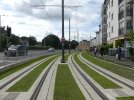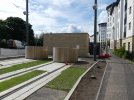The main difference is that last week's Man Utd vs Lyon game was the first Murrayfield event since the tram line was extended down Leith Walk. Therefore a good opportunity for staunch tram critics to highlight the overspend and imperfections on social media to a receptive audience. No offence intended by the way - I say that as a tram sceptic myself.
The only problem I had with it was that nearly 2 hours after the game apparently ended, there was still a massive problem with crowd and traffic dispersal from Georgie Road where public transport had been redirected
And for those unaware, the p and r site at ingleston was just about at capacity by mid morning on that day, I even saw it on FB down in Kent. Whilst this is a tram thread and I will unashamedly highlight the systems many faults and inadequacies it does perhaps pose a question about adequacy or lack thereof of Edinburgh's park and ride infrastructure, almost all of which was built a decade or so ago or in some cases more and in that decade the way the city is run and operated has changed massively.
The problem I see with Edinburgh is that it is, in my opinion a two and a half sided city, where if you think of it as a square with 4 sides, you'd say that one and a half of those sides is surrounded by the sea, so that limits entry and exit points.
In fact, with the pentlands, you could probably argue that takes another 'side' away from the city, so everything gets directed to the south eastwards of the Pentlands and westwards between the Pentlands and the FOF.
I encountered the same problem when I still lived at home and worked in Sunderland, I call that a three sided city, the east of it being the North Sea.
In both situations, it limits the availability of access routes both into and out of the city and those routes fill up quickly. To provide more public transport options, you're having to go further and further out of the city, which tends to defeat the object




